1 Introduction
Euro banknotes and coins are legal tender in the euro area. Cash is also an important payment instrument for ensuring that consumers have the freedom to choose how they pay, and it is essential for the financial inclusion of all groups in society. The Eurosystem cash strategy aims to ensure that euro cash remains widely available, accessible and accepted as both a means of payment and a store of value. Cash will also remain innovative, secure and environmentally friendly.
In this context, the European Central Bank (ECB) conducted for the first time the Companies’ Survey on Cash in 2021, with a second survey completed in 2024. The purpose of this survey is to understand companies’ views on the current and future use and acceptance of cash in payments, and how it compares with other means of payment. More specifically, the objectives of the survey are to understand:
- companies’ behaviour around accepting cash and their satisfaction with cash, including their acceptance of cash versus other means of payment and the perceived advantages of cash, and their satisfaction with the cash services provided by banks and cash-in-transit (CIT) companies and the availability of additional cash services such as “cashback” and “cash-in-shop” (see Annexes);
- companies’ views on the future of cash as a means of payment, including any plans to automate cash payments and the subsequent handling operations, as well as their plans for accepting cash in the future;
- companies’ behaviour in terms of cash withdrawals and deposits.
The sample of companies surveyed across all 20 euro area countries comprises companies employing one or more people in the following sectors: retail trade, restaurants and cafes, hotels, and arts, entertainment and recreation. These sectors were chosen because they have mostly private customers.[1] Employment weights were used to produce the results, meaning that companies with a higher number of employees have a larger impact on the results.[2]
Compared with the 2021 survey, the 2024 survey introduced a question on whether companies sell their products and services exclusively at physical locations, exclusively online, or both. For the euro area as a whole, the share of companies offering online sales in addition to sales at physical locations was 39%, and the share of companies selling products and services exclusively online was 6%. Companies that offer online sales were already included in the 2021 sample, but without any information about the proportion of all companies they account for. The potential increase in online sales in recent years should be taken into account when assessing the results, particularly in relation to companies’ acceptance of various payment instruments and their preferences in this area.
Throughout this report, the analysis has been done at euro area level, but when analysing the data at country level only, information on small and medium-sized enterprises’ (SMEs)[3] has been considered, as the sample size of large companies is considered not large enough at country level.
The key findings of the Companies’ Survey on Cash can be summarised as follows.
- Cash is the most accepted means of payment across euro area companies, with 88% accepting cash payments, closely followed by payment cards (85%). Companies also generally accept credit transfers (78%), direct debits (51%) and online or mobile payments (37%). Of the companies that accept cash, 94% expect to continue doing so over the next five years.
- 37% of companies prefer card payments, while 25% prefer cash payments and 21% prefer credit transfers.
- When deciding whether to accept a means of payment, the most important criteria for companies are security (94%) and reliability (92%). Companies generally consider cash to be better in terms of overall costs, reliability and privacy compared with other payment methods (cards and mobile payments).
- Most companies (70%) regularly deposit cash in their payment accounts. Of the companies depositing cash, the most popular methods are via cash-in machines (56%) and over the bank counter (49%).
- Around 30% of companies withdraw cash from their payment accounts. They mostly do so over the bank counter (51%) or via ATM withdrawals (49%).
- CIT services are less used in general, with only 21% of companies that withdraw cash and 17% of companies that deposit cash using these professional cash service providers. The vast majority of companies use their own staff to withdraw and deposit cash.
2 Accepted and preferred means of payments
This chapter describes companies’ acceptance of cash and other means of payment, their preferences between the different means of payment and their expectations of future cash acceptance.[4]
Cash is the most accepted means of payment, followed by cards and credit transfers, while cards are the preferred means of payment, followed by cash and credit transfers.
Security, reliability and ease of handling are the most important criteria for companies for accepting a payment method.
Companies consider cash to be better than other payment methods in terms of overall costs, reliability and privacy.
2.1 Accepted means of payment
Companies were asked which means of payment they accept.
Chart 1a shows that cash is the most frequently accepted means of payment, as the vast majority of euro area companies (88%) accept cash. Following cash, 85% accept payment with cards (this includes all types of cards, including debit, credit and prepaid cards) and 78% accept credit transfers. If the analysis is performed without taking into account the companies that sell their products and services exclusively online, the cash acceptance rate is slightly higher (90%).
If we look at the types of cards accepted, debit and credit cards are accepted by 80% of companies, while only 51% accept prepaid cards (Chart 1b). Contactless cards are accepted by 78% of companies (Chart 1c).
When comparing the acceptance of the various means of payments with the previous Companies’ Survey on Cash from 2021 (Chart 1a), the acceptance of cash has decreased by 8 percentage points (from 96% to 88%). This means that the percentage of companies who do not accept cash has increased strongly, from 4% to 12%. A similar decrease has been seen in the acceptance of all types of cards (from 93% to 85%). The reasons behind this decline in cash and cards acceptance are being analysed at country level to fully understand the country-specific factors at play. On the other hand, there has been an increase in the acceptance of direct debits (to 51% from 45%) and mobile payments (to 37% from 30%), while the acceptance of credit transfers has remained fairly stable. Additionally, Chart 1b shows that debit card acceptance has remained stable, while credit card acceptance has decreased by 7 percentage points (from 87% to 80%) between 2021 and 2024. In parallel, the acceptance of contactless payments has also declined, by 4 percentage points, as indicated in Chart 1c.
Chart 1
Accepted means of payment

Notes: The 2024 survey considers crypto-assets as a separate item, while in 2021 they were included as part of “Other”. The 2024 survey also included prepaid cards when asking about cards’ acceptance, but these were not mentioned in 2021.
Looking at the proportion of SMEs accepting cash at the country level, in almost all countries at least eight in ten SMEs accept cash as a means of payment in 2024 (Chart 2a).[5] Cash is most widely accepted in Ireland (96% of SMEs), France (94%) and Italy (93%). Cash acceptance has declined in most euro area countries since 2021 (Chart 2a), with the largest decrease in Cyprus (-28 percentage points), followed by Estonia and Slovakia (-13 percentage points). Cash acceptance has increased slightly in Malta (+5 percentage points), Ireland (+1 percentage points) and France (+1 percentage points).
Across the different sectors surveyed, which include all company sizes (Chart 2b), cash is accepted by the vast majority of retail trade companies (90%), restaurants and cafes (89%) and hotels (84%). These companies accept cash significantly more often than companies in the arts, entertainment and recreation sector (74%). A higher proportion (91%) of small companies (10 to 49 employees) and medium-sized companies (50 to 249 employees) accept cash compared with micro companies (1-9 employees – 87%) and large companies (250+ employees – 86%) (Chart 2c). Since the previous survey in 2021, the decrease in cash acceptance has affected all sectors and company sizes (Chart 2b and 2c), with the largest decrease experienced in hotels (-13 percentage points) and large companies (-13 percentage points).
Chart 2
Cash acceptance
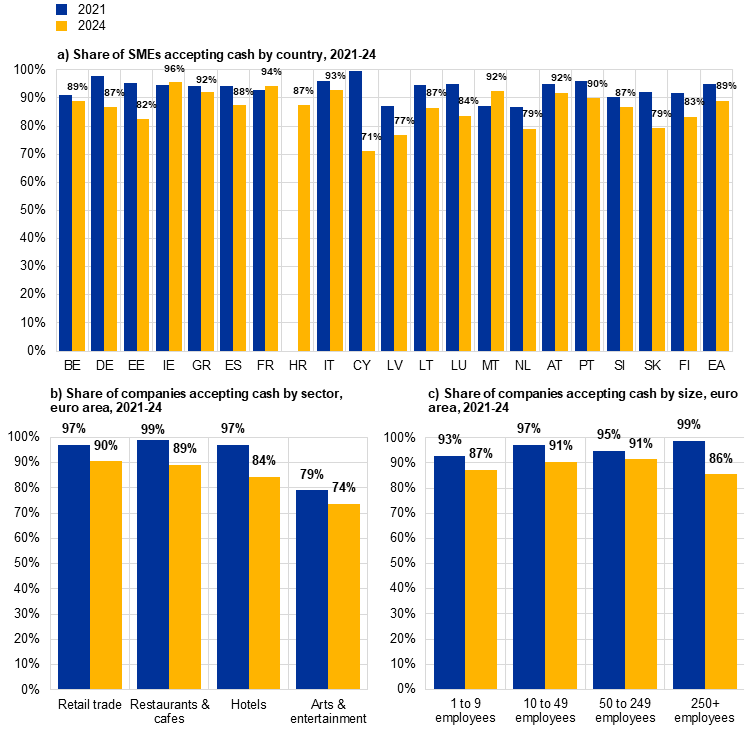
Note: Croatia joined the euro area in January 2023, so no data were collected for Croatia in the 2021 survey.
2.2 Change in cash acceptance across sectors
In the restaurants and cafes sector (Chart 3), for 18 of the 20 euro area countries the cash acceptance rate is above 90%, with the Netherlands (85%) and Luxembourg (86%) being the two exceptions. Since 2021 the level of cash acceptance has not changed significantly in most countries.
This is a very cash-intensive sector due to its unique characteristics and it has the highest cash acceptance rate of all sectors, with the euro area average standing at 95% in 2024.
Chart 3
Share of SMEs accepting cash in the restaurants and cafes sector by country, 2021-24
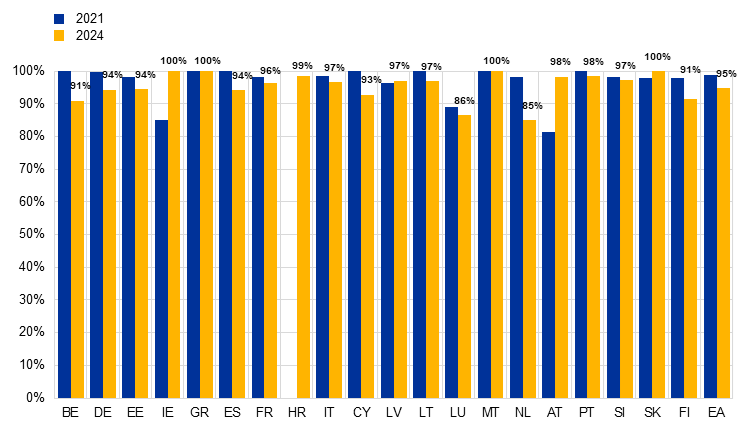
Notes: The restaurants and cafes sector accounts for 24% of the total companies surveyed.
Croatia joined the euro area in January 2023, so no data were collected for Croatia in the 2021 survey.
When we analyse cash acceptance in the retail trade sector (Chart 4), we can see that the acceptance rate has declined in most countries since 2021, with a decrease of more than 10 percentage points in nine countries. However, cash acceptance in this sector has increased in Italy (+1 percentage point) and Malta (+5 percentage points). The generalised decrease accounts for the 7 percentage point fall in cash acceptance at euro area level, from 96% in 2021 to 89% in 2024.
Chart 4
Share of SMEs accepting cash in the retail trade sector by country, 2021-24
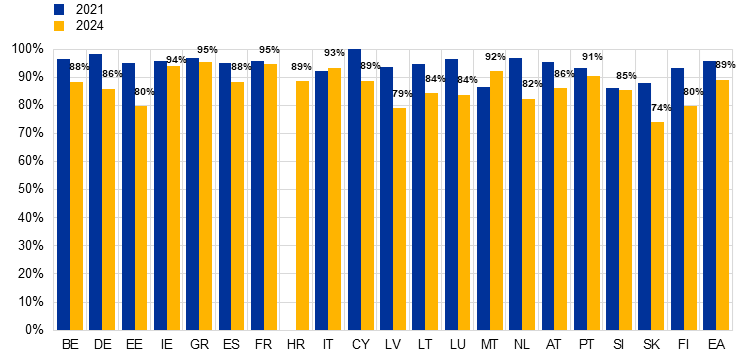
Note: The retail trade sector accounts for 51% of the total companies surveyed.
Croatia joined the euro area in January 2023, so no data were collected for Croatia in the 2021 survey.
The cash acceptance rate in the remaining analysed sectors has also declined at euro area level (Chart 2b). These sectors represent 18% (hotels) and 8% (arts, entertainment and recreation) of total employment in the sectors included in this survey. As such, the decline in cash acceptance observed in these sectors has had a low impact on the overall decline of 8 percentage points (Chart 1a).
2.3 Criteria for accepting a means of payment
Companies were asked how important certain criteria are when choosing to accept a means of payment. An overwhelming majority of companies in the euro area report that each of the criteria, aside from use by competitors, are either important or very important (Chart 5). However, the extent of that importance varies across the different criteria. Security of payment (e.g. against hacking or robbery) is seen as particularly important, with 94% of companies seeing it as either very important or important. The figures are nearly as high for reliability (92%) and ease of handling (90%), followed by overall costs (88%), transaction speed (88%), privacy (85%) and consumer preference (83%). Notably, most companies (45%) do not consider use by competitors to be an important criterion.
Chart 5
Criteria for accepting a means of payment
Importance of various criteria, euro area, 2024
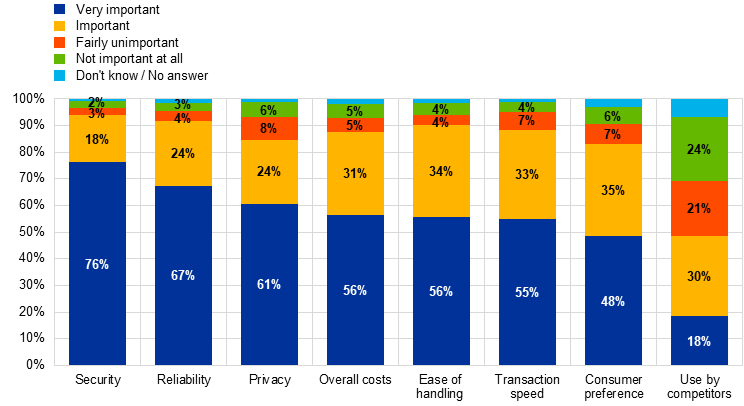
If we analyse security at country level (Chart 6a), as companies see it as the most important criteria overall, in all euro area countries, a majority of SMEs see security[6] as a very important criterion for accepting a means of payment. More than 85% of companies in Spain (87%), Slovenia (86%) and Portugal (85%) consider it to be very important. Security is an important or very important criterion across all sectors of interest (Chart 6b) and across all company sizes. Large companies with 250+ employees see it as particularly important, with 99% considering security to be “very important” or “important” (Chart 6c).
2.4 Reasons why companies are not accepting cash
Companies that responded that they don’t accept cash were asked a follow-up question to ascertain their reasoning (Chart 7a). The main reasons given were that cash is not used enough by customers (39%), “other” (25%), inconvenience of depositing or withdrawing cash (22%) and security risk (21%).
Chart 7
Reasons why cash is not accepted by companies
a) Euro area, 2024
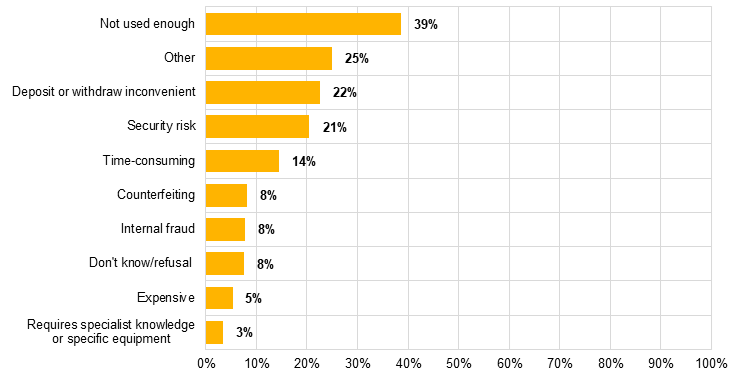
b) Most frequent reason why SMEs do not accept cash by country, 2024
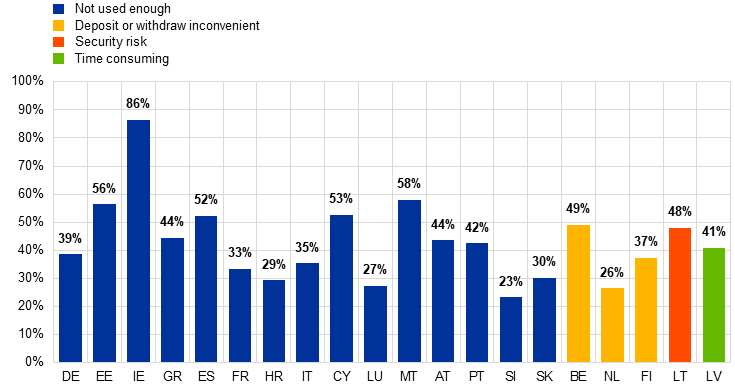
Notes: In most countries the most frequently cited reason for companies not accepting cash (ignoring “other” as it is not specific) is that cash is not used enough by their customers (Chart 7b). In Belgium, the Netherlands and Finland the main reason is the inconvenience of depositing or withdrawing cash, while in Lithuania it is the security risk (e.g. hacking or robbery) and in Latvia it is that the use of cash is time-consuming.
2.5 Preferred means of payment
Companies were asked the following question: “Which means of payment do you prefer your customers to use when paying you?”. As can be seen in Chart 8a, about one-third of companies prefer to be paid by card (37%), followed by cash (25%) and credit transfer (21%). Of the companies that only sell their products at physical locations, 29% prefer cash payments, with this figure falling to 20% for companies that sell their products both online and in physical locations.
When analysing the evolution of companies’ preferences since 2021, we can see that there has been a significant decrease of 16 percentage points in companies preferring to be paid by card (from 53% in 2021 to 37% in 2024), while the preference for cash has remained stable and the preference for credit transfers has increased by 5 percentage points (from 16% to 21%). An increasing proportion of companies prefer to be paid by direct debit and mobile payments, but the share of companies preferring these methods is still rather small.
For the companies that prefer card payments, follow-up questions explored their preferences for card types and technologies. Chart 8b indicates that 40% of these companies prefer to be paid by debit card, while only 14% prefer credit cards, and Chart 8c shows that contactless payment technologies are preferred by 42%. When asked about their preference regarding card types and technologies, a large share of companies were indifferent.
Chart 8
Which means of payment do companies prefer to be paid with?
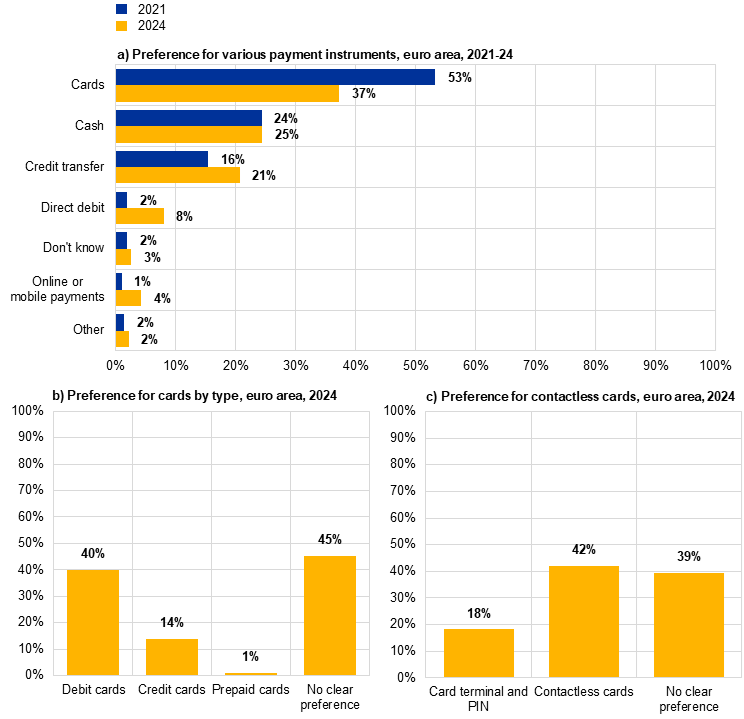
Notes: Preferences for “crypto-assets”, “bank cheques” and “gift cards” have been combined in the “Other” category, and individually they were all below 1%. The 2024 survey included prepaid cards under “Cards”, but prepaid cards were not considered in the 2021 survey.
When we analyse SMEs’ cash preferences at country level (Chart 9a), we see that there are significant differences between countries. Austria stands out with a cash preference of 54%, followed by Croatia (39%), and Italy and Slovenia with 37%, while on the opposite side we find Malta (9%) and Finland, where only 8% of SMEs prefer being paid with cash. Looking at the changes compared with the previous survey in 2021, the preference for cash has only declined in six euro area countries, with Malta experiencing the highest decrease of 16 percentage points. In the rest of the euro area countries, SMEs’ preference for cash has increased or remained stable.
Comparing the four sectors of interest (Chart 9b), restaurants and cafes have the largest share of companies preferring cash (42%), followed by hotels (27%), with the latter sector experiencing an increase of 6 percentage points in companies’ preference for cash. On the other side, in the arts, entertainment and recreation sector the preference for cash has decreased by 9 percentage points (from 23% in 2021 to 14% in 2024).
Analysing cash preference by company size (Chart 9c), we can see that the share of micro companies (1-9 employees) and small companies (10-49 employees) that prefer to be paid in cash is significantly higher than the share of larger companies that have that preference, and these preferences have remained stable from 2021 to 2024.
Chart 9
Share of companies that prefer being paid in cash

Note: Croatia joined the euro area in January 2023, so no data were collected for Croatia in the 2021 survey.
2.6 Cash versus other means of payment
Another important series of questions concerned how cash compares with card payments (with or without using contactless technology), and how it compares with mobile payments, in terms of overall costs, transaction speed, ease of handling, reliability/sensitivity to malfunctioning, security and privacy.
Cash is rated much better or slightly better in all these features in comparison with cards (both with and without contactless technology) and mobile payments. The characteristics that are considered more favourable for cash are lower costs[7], higher reliability/less sensitivity to malfunctioning and better preservation of privacy.
It is important to note that the Companies’ Survey on Cash collects the perceptions of companies rather than the actual transaction speed.
Chart 10
Cash versus other means of payment
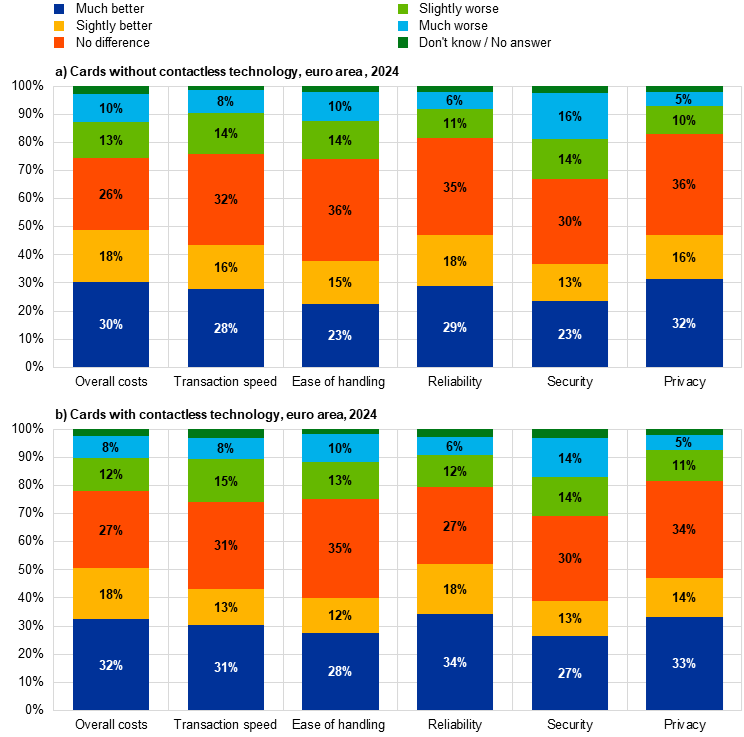
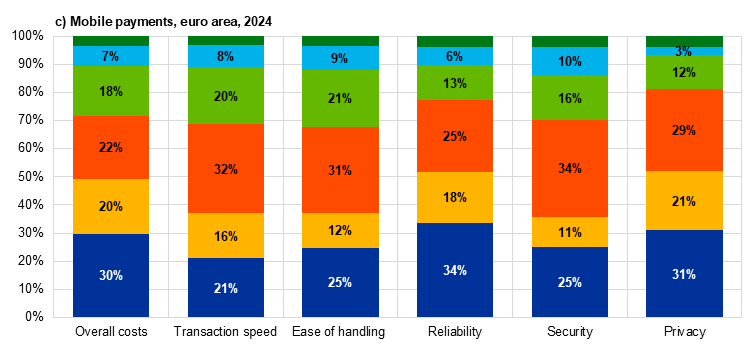
2.7 Future cash acceptance and reasons
Companies that accept cash were asked whether they expect to continue doing so in the next five years. Over nine in ten (94%) of companies who currently accept cash said that they think they will continue to do so (Chart 11a), while 4% said that they will not.
Those companies that said that they will stop accepting cash in the next five years were asked a follow-up question to understand their reasons (Chart 11b). Around one-third of the companies said that they might stop accepting cash because it is not used often enough by their clients (34%), while slightly over one-quarter said it is costly (29%) and 21% said it is related to the risk of internal fraud or other reasons not specified in the question asked.
Chart 11
Future cash acceptance and reasons for non-acceptance
a) Future cash acceptance, euro area, 2024 | b) Reasons for non-acceptance, euro area, 2024 |
|---|---|
 |  |
3 Cash withdrawal and deposit behaviour
This section examines the cash withdrawal and deposit behaviours of companies by asking: “Does your company do any of the following: withdraw cash, deposit cash or use services provided by a cash-in-transit (CIT) company?”.
While a high share of companies (70%) deposit cash, far fewer make cash withdrawals (30%). Both deposit and withdrawal behaviours vary considerably across countries (Chart 12b). While 59% of SMEs in Cyprus and Ireland said they withdraw cash, the share is below 20% in Malta (10%), Latvia (17%) and Luxembourg (18%). Greece and Malta have the largest proportion of companies that deposit cash (both 89%), while Croatia (43%) and Lithuania (48%) have the lowest.
Cash withdrawals and deposits have undergone changes since 2021. There has been a noticeable drop in the share of companies depositing cash in 2024 (-15 percentage points). Over the same period, cash withdrawals have increased slightly (+2 percentage points).
Chart 12
Share of companies that withdraw or deposit cash
3.1 Cash withdrawals
The primary method for withdrawing cash is to withdraw banknotes and coins over the bank counter, utilised by 51% of respondents who withdraw cash (Chart 13a). ATM withdrawals are used by 49% of companies, while 21% opt for a CIT company.
Most of these figures have remained relatively stable since 2021. Nevertheless, the decline in over-the-counter withdrawals is particularly noticeable (-13 percentage points).
Chart 13
How companies withdraw cash
a) Euro area, 2021-24 | b) Most frequent cash withdrawal method among SMEs by country and method, 2024 |
|---|---|
 |  |
Notes: The figures reported are euro area aggregates for the four sectors of interest: retail trade, hotels, restaurants and cafes, and arts, entertainment, and recreation. Respondents were asked to report all cases that apply.
There are significant disparities between countries with respect to the methods used for withdrawing cash (Chart 13b). In 11 countries, withdrawing cash over the bank counter is the most frequently used method, while cash withdrawal via an ATM is the most prevalent in nine countries. Meanwhile, CIT is not the most frequently used withdrawal method in any country.
Chart 14
Why companies withdraw cash
a) Euro area, 2021-24 | b) Share of SMEs withdrawing cash to have change available by country, 2024 |
|---|---|
 |  |
Notes: The figures reported are euro area aggregates for the four sectors of interest: retail trade, hotels, restaurants and cafes, and arts, entertainment, and recreation. Respondents were asked to report all cases that apply.
Concerning the reasons for withdrawing cash, companies do so mostly in order to have change (coins and smaller banknote denominations) available (77%) (Chart 14a). Over one-fifth (23%) said that they withdraw cash to pay suppliers, while around one in ten do so to pay taxes or other bills (11%). Lower shares of companies withdraw cash to pay salaries (6%) or for other reasons (7%). These figures have only changed slightly since 2021.
When performing the country analysis of SMEs that withdraw cash to have change available, we can see that there are relevant differences between countries, with the share in Belgium at 94%, while in Cyprus and Portugal it is only 43%. The euro area average is 75%.
3.2 Cash deposit
70% of companies deposit cash, with the majority opting for ATMs with online depositing function – so-called cash-in machines (56%) – or the bank counter (49%), as indicated in Chart 15a. A smaller share of companies rely on CIT companies (17%) and night vaults (14%) for their cash deposits.
There have not been significant changes compared to 2021 for any type of deposit, with the only increase being the slight uptick in the use of cash-in machines (from 53% to 56%).
Cash-in machines are the most frequently used method to deposit cash in 13 countries (Chart 15b), while depositing cash at bank counters is the most popular method in six countries.
Chart 15
How companies deposit cash
4 Automation of cash operations
The following section provides an overview of the current and future state of the automation of cash operations, such as cashier desks with smart tills or self-checkout terminals that accept cash from customers.
Companies were asked whether they have automated their cash operations and, if not, whether they are planning to do so in the future. It is important to better understand how companies handle cash as part of their professional activities and whether this could save some of the costs of cash-handling activities. According to the information collected, a little over one-third of companies have automated (parts of) their cash operations. Of those who have not already turned to automation, the majority have no plans to do so.
On average across the euro area, 66% of companies have not automated their cash operations. Of the companies that have, 20% have installed smart cash tills, 10% have introduced checkout terminals that accept cash, and 10% have employed other automation systems (Chart 16a).
Companies that said they had not automated their cash services were asked a follow-up question about whether they are planning to do so in the future. An overwhelming majority (85%) said that they are not planning to do so (Chart 16b), while only 6% are planning to introduce smart tills and 4% intend to introduce self-checkout terminals that accept cash.
Chart 16
Cash automation
a) Have you automated your cash operations? Euro area, 2024

b) Do you plan to automate cash operations in the future? Euro area, 2024
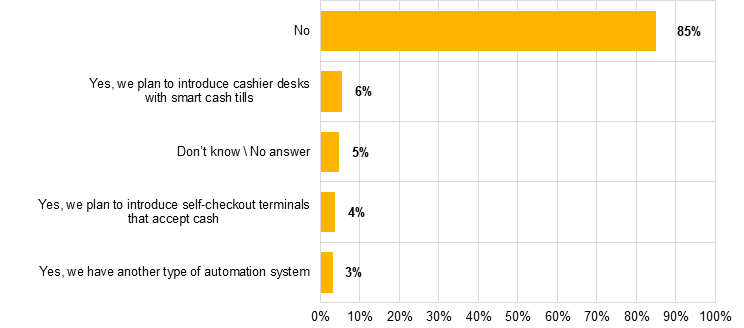
5 Conclusions
Euro banknotes and coins are widely accepted by companies as a means of payment across all surveyed sectors.[8] However, the level of cash acceptance has decreased compared with the 2021 Companies’ Survey on Cash, mainly driven by the retail trade sector. Overall, the share of companies not accepting cash has increased from 4% to 12%. Of the companies that do accept cash, 94% expect to continue doing so over the next five years, which will have an impact on the future cash acceptance rate. These results should be interpreted cautiously as they only reflect information for companies in the surveyed sectors and do not reflect information from all participants in the cash cycle (e.g. citizens are not included).
Card payments (credit, debit and prepaid cards) are also widely accepted by a large majority of companies, but their acceptance has also decreased compared with 2021. Online and mobile payments are accepted by a significantly lower share (around 37%) of companies. While this is an increase compared with 2021, it is still fairly low in comparison with cash and cards.
The report shows that one-third of companies prefer their customers to pay with cards, while one in four prefer payments in cash. Additionally, the share of companies that prefer payments by credit transfer and direct debit has increased since the previous survey in 2021.
When deciding to accept a means of payment, security (94%), reliability (92%) and ease of handling (90%) are the most important criteria for companies. Companies generally consider cash as the best option in terms of overall costs, reliability and privacy compared with other payment methods (cards and mobile payments).
Annex A
Methodology
Scope
The Study on the use of cash by households in the euro area[9] from 2017 and the ECB’s regular Study on the payment attitudes of consumers in the euro area (SPACE) analyse consumers’ payment behaviour and habits to assess how consumers use cash and non-cash means of payment.
As cash is still the only form of public money, there is a need to analyse the other side of the payment process, from the merchant’s or payee’s perspective. The scope of the Companies’ Survey on Cash is to provide an overview of companies’ views on the current and future use and acceptance of cash. The study was performed for the first time in 2021 and has been repeated in 2024 with the same methodological framework.[10]
All 20 euro area countries (Belgium, Germany, Estonia, Ireland, Greece, Spain, France, Croatia, Italy, Cyprus, Latvia, Lithuania, Luxembourg, Malta, Netherlands, Austria, Portugal, Slovenia, Slovakia, and Finland) are covered in the 2024 survey.
Sample design and data collection
In this survey the statistical unit is the enterprise, which is defined as a company or professional undertaking with at least one employee. The respondent is a person with capacity within the company to take decisions related to the accepted means of payment, such as the owner, chief financial officer, head of accountancy, etc. To improve response rates, the ECB provides respondents with an official letter (on request) that explains the purpose of the survey.
The survey mode is a telephone interview.
The sample is a quota sample, stratified in each country by sector (as classified in Eurostat’s list of NACE codes), and additionally by size of enterprise. The survey was conducted among companies in the following sectors: retail trade, accommodation and food service activities, and arts, entertainment and recreation.
The data were collected by the survey company Verian in one wave between February and March 2024. Fieldwork was carefully monitored in cooperation with Verian and the ECB at all stages.
The sample was selected from an international business database. The focus of this report, as mentioned in the introduction, is the sectors that are most likely to receive payments from private consumers in cash. Therefore, the enterprises in the retail trade sector (NACE G45+G47) account for at least 60% of the sample, and were stratified by following size classes: micro (1-9 employees), small (10-49), medium (50-249) and large (250+). Minimum quotas for micro and small enterprises were also applied.
Enterprises in accommodation and food service activities (NACE I) account for at least 20% of the sample, while those in arts, entertainment and recreation (NACE R) account for at least 10%. Enterprises in all size classes mentioned were also covered, and the coverage of large enterprises was only a requirement in countries in which the total sample size was 400 or more.
By then end of the fieldwork, a total of 7,675 interviews had been conducted for all the companies. Table 1 shows the distribution of the sample by country.
Table A1
Total sample achieved by country
Country | Sample achieved |
|---|---|
Belgium | 402 |
Germany | 859 |
Estonia | 200 |
Ireland | 200 |
Greece | 400 |
Spain | 896 |
France | 900 |
Croatia | 251 |
Italy | 900 |
Cyprus | 100 |
Latvia | 200 |
Lithuania | 199 |
Luxembourg | 100 |
Malta | 100 |
Netherlands | 410 |
Austria | 385 |
Portugal | 398 |
Slovenia | 198 |
Slovakia | 201 |
Finland | 376 |
TOTAL | 7,675 |
Table A2
Total sample achieved by company size
Company size | Sample achieved |
|---|---|
1 to 9 employees | 5,219 |
10 to 49 employees | 2,038 |
50 to 249 employees | 317 |
250+ employees | 101 |
TOTAL | 7,675 |
Table A3
Total sample achieved by sector
Weighting and validation of the data
The data have gone through quality checks, validation and weighting.
Outlier detection was performed, observations that were far away from most of all other observations were deleted and imputation of missing values was done.
The data were weighted to ensure that the net sample was representative of the population, so as to minimise the bias of the survey estimate and to enable solid inferences to be drawn.
The data and the results presented in the report are weighted using an employee weight, which weights the data in each size class, economic sector and country according to the population estimates based on the number of employees. Hence, the “employee” weight ensures the sample is weighted in proportion to the total number of employees in each weighting cell. Most of the population targets were obtained from Eurostat’s two sources for business statistics: structural business statistics (SBS) and business demography (BD).
The weighting was done in two stages. The first stage involved calculating the weights within each sector with a specific quota. This ensured that the oversampling of large enterprises was compensated for. The second stage took a calibration weight for each sector that simply calibrated the samples for the four specific quotas to their relative employee population estimates.
Annex B
List of sectors sampled in the survey
- Retail trade
- Hotels
- Restaurants and cafes
- Arts, entertainment and recreation
- Don’t know / No answer
Annex C Survey
Survey screener
D1. In which sector does your company carry out its main activities?
- Retail trade
- Hotels
- Restaurants and cafes
- Arts, entertainment and recreation
- Other
- Don’t know / No answer
- Refusal
If D1=5, 6, 7, end survey
ASK D1b if D1=1
D1b. As part of the retail trade, what is your company’s main business?
- Supermarket
- Shops for day-to-day items (e.g. convenience store, bakery, drugstore, pharmacy)
- Street vendor or at a market (e.g. newspaper stand, florist, lottery, second-hand purchases)
- Shop selling durable goods (e.g. clothing, toys, electronics, household appliances, furniture, speciality shops)
- Petrol station
- Other
- Don’t know / No answer
- Refusal
D2. What is your position in the company?
- CEO/Managing director/President
- CFO/Controller
- Financial director/manager
- Senior accountant
- Owner
- Other
- Don’t know / No answer
- Refusal
D3. Is your company...?
- Independent
- A franchise undertaking
- A branch of a national group
- A branch of an international group
- The headquarters of a national group
- The headquarters of an international group
- Don’t know / No answer
- Refusal
D4. How many employees (full-time equivalent), including yourself, does your company, as a whole, currently have?
Numerical question: (Insert value between 1 and 9999997)
D4b. How certain are you about the number you have just provided?
- Very certain
- Fairly certain
- Fairly uncertain
- Not certain at all
D7. Where does your company sell your products/services?
- At physical locations
- Online
- Both online and at physical locations
- Don’t know / No answer
- Refusal
Q16. What would you say is your company’s approximate annual turnover?
Numerical question: (Insert value between 1 and 99999997)
D16b. How certain are you about the number you have just provided?
- Very certain
- Fairly certain
- Fairly uncertain
- Not certain at all
Q17. Thinking of your annual turnover, approximately what proportion of your income from customers is in cash?
Numerical question: (Insert value between 1% and 100%)
Q18. What is the average amount of cash that you normally hold (e.g. in the till, in a vault or safe)?
Numerical question: (Insert value between 1 and 99999997)
Questionnaire Part 1
Acceptance of cash and preferences
Q1. Which means of payment does your company accept?
- Cash
- Card (i.e. debit, credit and prepaid cards)
- Bank cheque [only in countries that have bank cheques*]
- Credit transfer
- Direct debit or e-invoice
- Gift card, voucher or loyalty points
- Online or mobile payment (e.g. PayPal, Klarna, Sofort)
- Crypto-asset (e.g. Bitcoin, Ethereum)
- Other
- Don’t know / No answer
- Refusal
*option not presented in Belgium, Latvia, Lithuania and Slovakia
ASK Q1b IF Q1=2 (accepts cards)
Q1b. As part of the card payments, what types of card do you accept?
- Debit card
- Credit card
- Prepaid card*
- Don’t know / No answer
- Refusal
* option not presented in Lithuania
ASK Q1c IF Q1=2 (accepts cards)
Q1c. As part of the card payments, do you accept contactless payments, which allow customers to pay without inserting their card into a terminal, at least for some card types?
- Yes
- No
- Don’t know / No answer
- Refusal
ASK Q1d IF Q1=7 (online or mobile payment)
Q1d. Which online or mobile payments does your company accept?
- PayPal
- Payment wallets (e.g. Apple Pay, Google Pay, Samsung Pay, Android Pay, Amazon Pay, Fitbit Pay, Garmin Pay, etc.)
- Other mobile payments* (e.g. Klarna, Sofort, iDEAL, Satispay, Payconiq, Paylib, etc.)
- Instant payments (i.e. payments made without using a card, with the payment being received within seconds of a payment order being made, also during weekends)
- Other (e.g. your own store payment app)
- Don’t know / No answer
- Refusal
* option not presented in Lithuania
ASK Q2b IF Q1≠1 (company does not accept cash) AND D7=1 (physical stores)
Q2b. How long has it been since you permanently stopped accepting cash?
- Less than 1 year
- 1 to 2 years
- 2 to 5 years
- More than 5 years
- We have never accepted cash
- Don’t know / No answer
- Refusal
ASK Q2c IF Q1≠1 (company does not accept cash) AND D7=1 (physical stores)
Q2c. What are your reasons for not accepting cash?
- It requires specialist knowledge or equipment to handle
- It is expensive (e.g. high bank fees)
- It is time-consuming
- It is risky in terms of internal fraud
- It poses a security risk (i.e. robbery)
- It is inconvenient or difficult to deposit or withdraw cash (e.g. short working hours, long travel distance)
- It has a high risk of counterfeiting
- It is not used often enough by our customers
- Other
- None
- Don’t know / No answer
- Refusal
Ask Q3 if Q1=1
Q3. Do you think you will continue accepting cash in the next five years?
- Yes
- No
- Don’t know / No answer
- Refusal
ASK Q5 IF Q3=2
Q5. Why would you not accept cash in the next five years?
- It requires specialist knowledge or equipment to handle
- It is expensive (e.g. high bank fees)
- It is time-consuming
- It is risky in terms of internal fraud
- It poses a security risk (i.e. robbery)
- It is inconvenient or difficult to deposit or withdraw (e.g. short working hours, long travel distance)
- It has a high risk of counterfeiting
- It is not used often enough by our customers
- Other
- None
- Don’t know / No answer
- Refusal
Q33. Do you believe it is legal not to accept cash?
- Yes
- No
- Only in exceptional cases
- Don’t know / No answer
- Refusal
ASK Q6 IF Q1=1
Q6. What aspects of the cash supply do you think need improvement?
- Logistics costs associated with depositing and withdrawing cash
- Availability (more frequent) of cash depositing and withdrawing services
- Storage solutions on-site
- Automatic counting or balancing of the cash register
- Faster debiting of my cash balance into my bank account
- Safety
- Supply of coins
- Convenient depositing of coins
- The characteristics of banknotes (size, denomination, material)
- Other
- None
- Don’t know / No answer
- Refusal
Q7. How important are the following criteria for your company when choosing to accept a means of payment?
Not important at all | Fairly unimportant | Fairly important | Very important | Don’t know / No answer | Refusal | |
|---|---|---|---|---|---|---|
Overall costs | 1 | 2 | 3 | 4 | 9999998 | 9999999 |
Transaction speed | 1 | 2 | 3 | 4 | 9999998 | 9999999 |
Ease of handling | 1 | 2 | 3 | 4 | 9999998 | 9999999 |
Reliability/sensitivity to malfunctioning | 1 | 2 | 3 | 4 | 9999998 | 9999999 |
Security (e.g. hacking, robbery) | 1 | 2 | 3 | 4 | 9999998 | 9999999 |
Consumer preference | 1 | 2 | 3 | 4 | 9999998 | 9999999 |
Use by competitors | 1 | 2 | 3 | 4 | 9999998 | 9999999 |
Privacy | 1 | 2 | 3 | 4 | 9999998 | 9999999 |
ASK Q8a IF Q1=1 and Q1=2 (company accepts cash and card payments)
Q8a. How does cash compare with card payments used without contactless technology in terms of…?
Much better | Slightly better | No difference | Slightly worse | Much worse | Don’t know / No answer | Refusal | |
|---|---|---|---|---|---|---|---|
Overall costs | 1 | 2 | 3 | 4 | 5 | 9999998 | 9999999 |
Transaction speed | 1 | 2 | 3 | 4 | 5 | 9999998 | 9999999 |
Ease of handling | 1 | 2 | 3 | 4 | 5 | 9999998 | 9999999 |
Reliability/sensitivity to malfunctioning | 1 | 2 | 3 | 4 | 5 | 9999998 | 9999999 |
Security (e.g. hacking, robbery) | 1 | 2 | 3 | 4 | 5 | 9999998 | 9999999 |
Privacy | 1 | 2 | 3 | 4 | 5 | 9999998 | 9999999 |
ASK Q8b IF Q1=1 and Q1=2 and Q1c=1 (company accepts cash and card payments with contactless technology)
Q8b. How does cash compare with card payments using contactless technology in terms of…?
Much better | Slightly better | No difference | Slightly worse | Much worse | Don’t know / No answer | Refusal | |
|---|---|---|---|---|---|---|---|
Overall costs | 1 | 2 | 3 | 4 | 5 | 9999998 | 9999999 |
Transaction speed | 1 | 2 | 3 | 4 | 5 | 9999998 | 9999999 |
Ease of handling | 1 | 2 | 3 | 4 | 5 | 9999998 | 9999999 |
Reliability/sensitivity to malfunctioning | 1 | 2 | 3 | 4 | 5 | 9999998 | 9999999 |
Security (e.g. hacking, robbery) | 1 | 2 | 3 | 4 | 5 | 9999998 | 9999999 |
Privacy | 1 | 2 | 3 | 4 | 5 | 9999998 | 9999999 |
ASK Q8e IF Q1=1 and Q1=7 (company accepts cash and mobile payments)
Q8e. How does cash compare with mobile payments in terms of…?
Much better | Slightly better | No difference | Slightly worse | Much worse | Don’t know / No answer | Refusal – | |
|---|---|---|---|---|---|---|---|
Overall costs | 1 | 2 | 3 | 4 | 5 | 9999998 | 9999999 |
Transaction speed | 1 | 2 | 3 | 4 | 5 | 9999998 | 9999999 |
Ease of handling | 1 | 2 | 3 | 4 | 5 | 9999998 | 9999999 |
Reliability/sensitivity to malfunctioning | 1 | 2 | 3 | 4 | 5 | 9999998 | 9999999 |
Security (e.g. hacking, robbery) | 1 | 2 | 3 | 4 | 5 | 9999998 | 9999999 |
Privacy | 1 | 2 | 3 | 4 | 5 | 9999998 | 9999999 |
Q9. Which means of payment would you prefer your customers to use when paying you?
- Cash
- Card (i.e. debit, credit and prepaid cards)
- Bank cheque [only in countries that have bank cheques*]
- Credit transfer
- Direct debit or e-invoices
- Gift card, voucher or loyalty points
- Online or mobile payment
- Crypto-asset (e.g. Bitcoin, Ethereum)
- Other
- Don’t know / No answer
- Refusal
* option not presented in Belgium, Latvia, Lithuania and Slovakia
ASK Q9b IF Q9=2 (prefers card payments)
Q9b. As part of the card payments, which ones would you prefer?
- Debit card
- Credit card
- Prepaid card*
- I don’t have any clear preference
- Don’t know / No answer
- Refusal
* option not presented in Lithuania
ASK Q9c IF Q9=2 (prefers card payments)
Q9c. As part of the card payments, which technology would you prefer your customers to use?
- Inserting the card into a terminal and confirming the payment with a PIN code
- Contactless technology (not inserting the card into a terminal)
- I don’t have any clear preference
- Don’t know / No answer
- Refusal
ASK Q9d IF Q9=7 (prefers mobile payments)
Q9d. As part of the online or mobile payments, which ones would you prefer your customers to use?
- PayPal
- Payment wallets (e.g. Apple Pay, Google Pay, Samsung Pay, Android Pay, Amazon Pay, Garmin Pay, etc.)
- Other mobile payments* (e.g. Klarna, Sofort, iDEAL, Satispay, Payconiq, Paylib, etc.)
- Instant payments (i.e. payments made without using a card, with the payment being received within seconds of a payment order being made, also during weekends)
- Other (e.g. your own store payment app)
- Don’t know / No answer
- Refusal
* option not presented in Lithuania
Questionnaire Part 2
Additional cash services
ASK Q10 IF Q1=1 (companies that accept cash)
Q10. Have you automated your cash operations?
- Yes, we have cashier desks with smart cash tills
- Yes, we have self-checkout terminals that accept cash
- Yes, we have another automation system
- No
- Don’t know / No answer
- Refusal
ASK Q11 IF Q10=4 (no automated cash operations)
Q11. Do you plan to automate your cash operations in the future?
- Yes, we plan to introduce cashier desks with smart tills
- Yes, we plan to introduce self-checkout terminals that accept cash
- Yes, we plan to introduce another automation system
- No
- Don’t know / No answer
- Refusal
ASK Q12a IF AND Q=1 (companies that accept cash)
Q12a. Cashback is the possibility given to a customer to withdraw cash as part of a purchase made with a card. This option does not refer to the change given as part of a purchase. Do you offer this service to your customers?
- Yes
- No
- Don’t know / No answer
- Refusal
ASK Q12b IF AND Q=1 (retailers, hotels, restaurants and arts/entertainment that accept cash)
Q12b. Cash-in-shop means that customer can ask to withdraw cash via their card without purchasing anything in your establishment. Do you offer this service to your customers?
- Yes
- No
- Don’t know / No answer
- Refusal
ASK Q13a, IF Q12a=2 (no cashback services)
Q13a. Why do you not offer cashback services to your customers?
- The service would not be used by your customers
- The set-up costs are too high
- The fees charged by the providers are too high
- There is not enough excess cash for supplying these services
- We are not familiar with this type of service
- Security reasons (e.g. robbery)
- Possibility of internal fraud
- The legal framework related to it is unknown to us
- There are no advantages to us using it
- Other
- Don’t know / No answer
- Refusal
ASK 13b, IF Q12b=2 (no cash-in-shop services)
Q13b. Why do you not offer cash-in-shop services to your customers?
- The service would not be used by your customers
- The set-up costs are too high
- The fees charged by the providers are too high
- There is not enough excess cash for supplying these services
- We are not familiar with this type of service
- Security reasons (e.g. robbery)
- Possibility of internal fraud
- The legal framework related to it is unknown to us
- There are no advantages to us using it
- Other
- Don’t know / No answer
- Refusal
Questionnaire Part 3
Withdrawal and deposit behaviour
ASK ALL
Q19. Does your company do any of the following…?
Yes | No | Don’t know / | Refusal | |
|---|---|---|---|---|
Withdraw cash | 1 | 0 | 9999998 | 9999999 |
Deposit cash | 1 | 0 | 9999998 | 9999999 |
Use services provided by a cash-in-transit (CIT) company | 1 | 0 | 9999998 | 9999999 |
ASK Q20 IF Q19_1=1 (company withdraws cash)
ASK Q20 item 3 (by using a CIT) IF Q19_3=1
Q20. How does your company withdraw cash?
- Over the bank counter
- Via an ATM
- By using a cash-in-transit company
- Using cashback and/or cash-in-shop services
- Other
- Don’t know / No answer
- Refusal
ASK Q21a IF Q20=1 (use bank counter for withdrawal)
Q21a. How easy or difficult is it for you or someone else from your company to get to a bank to withdraw cash over the counter?
- Very easy
- Fairly easy
- Fairly difficult
- Very difficult
- Don’t know / No answer
- Refusal
ASK Q21b IF Q21=2 (use ATM for withdrawal)
Q21b. How easy or difficult is it for you or someone else from your company to get to an ATM to withdraw cash?
- Very easy
- Fairly easy
- Fairly difficult
- Very difficult
- Don’t know / No answer
- Refusal
ASK Q22 IF Q19_1=1 (company withdraws cash)
Q22. Why does your company withdraw cash?
- To have change
- To pay suppliers
- To pay salaries
- To pay taxes or other bills
- Other
- Don’t know / No answer
- Refusal
ASK Q31a IF Q19_1=1 (withdraws cash)
Q31a. Do you consider the fees charged by your commercial bank/s or other cash suppliers for withdrawing cash (banknotes and coins) to be reasonable?
- Yes
- No
- Don’t know / No answer
- Refusal
ASK Q23 to Q26 IF Q19_2=1 (company deposits cash)
Q23. How does your company deposit cash?
- Over the bank counter
- In a bank night vault (seal bag machines)
- Via a cash-in machine
- By using a cash-in-transit company
- By using cash-in-shop services
- Other
- Don’t know / No answer
- Refusal
ASK Q24a IF Q23=1 (use bank counter for deposit)
Q24a. How easy or difficult is it for you or someone else from your company to get to a bank to deposit cash over the counter?
- Very easy
- Fairly easy
- Fairly difficult
- Very difficult
- Don’t know / No answer
- Refusal
ASK Q24b IF Q23=2 (use bank night vault for deposit)
Q24b. How easy or difficult is it for you or someone else from your company to get to a bank night vault (seal bag machine) to deposit cash?
- Very easy
- Fairly easy
- Fairly difficult
- Very difficult
- Don’t know / No answer
- Refusal
ASK Q24c IF Q23=3 (use cash-in machine for deposit)
Q24c. How easy or difficult is it for you or someone else from your company to get to a cash-in depositing machine to deposit cash?
- Very easy
- Fairly easy
- Fairly difficult
- Very difficult
- Don’t know / No answer
- Refusal
ASK Q31b IF Q19_1=2 (deposits cash)
Q31b. Do you consider the fees charged by your commercial bank/s or other cash suppliers for depositing cash (banknotes and coins) to be reasonable?
- Yes
- No
- Don’t know / No answer
- Refusal
ASK Q25 if Q19_2=1 (company deposits cash)
Q25. On average, how often does your company deposit cash?
- More than 5 times per week
- 3 to 5 times per week
- Once or twice per week
- Less than once a week
- About once every second week
- About once a month
- Less often
- Don’t know / No answer
- Refusal
ASK Q34 IF Q23=5 OR Q20=4
Q34. Why do you use non-traditional points of access to cash (cashback and/or cash-in-shop) to deposit or withdraw cash?
- These services are offered by providers closer to our offices/stores
- These services have more convenient and extended opening hours
- These services allow for an additional number of deposits/withdrawals throughout the week/month
- The fees for these services are lower
- The cash amounts that you deposit/withdraw are small, therefore these services are more convenient
- Don’t know / No answer
- Refusal
ASK Q28 and Q29 IF Q19_3=1
Q28. Please indicate for which services you use a cash-in-transit (CIT) company
- Cash transportation services
- Cash-handling services
- Security services
- Smart tills services
- Other
- Prefer not to say
- Don’t know / No answer
- Refusal
ASK Q30 IF Q19_1=1 or Q19_2=1
Q30a. How have the cash services provided by the commercial banks that you work with evolved over the last three years?
Deteriorated a lot | Somewhat deteriorated | Not changed | Somewhat improved | Improved | Don’t know / No answer | Refusal | |
|---|---|---|---|---|---|---|---|
Availability and distance to locations to withdraw and deposit banknotes | 1 | 2 | 3 | 4 | 5 | 9999998 | 9999999 |
Availability and distance to locations to withdraw and deposit coins | 1 | 2 | 3 | 4 | 5 | 9999998 | 9999999 |
Range of products provided (e.g. types of accounts, personal banker or assistance if needed, cash vaults, etc.) | 1 | 2 | 3 | 4 | 5 | 9999998 | 9999999 |
Available opening hours | 1 | 2 | 3 | 4 | 5 | 9999998 | 9999999 |
Limits on the amount or number of deposits and withdrawals | 1 | 2 | 3 | 4 | 5 | 9999998 | 9999999 |
Total fees paid | 1 | 2 | 3 | 4 | 5 | 9999998 | 9999999 |
ASK Q30 IF Q19_3=1
Q30b. How have the cash services provided by the cash-in-transit companies (CITs) that you work with evolved over the last three years?
Deteriorated a lot | Somewhat deteriorated | Not changed | Somewhat improved | Improved a lot | Don’t know / No answer | Refusal | |
|---|---|---|---|---|---|---|---|
The range of products provided (e.g. transportation, security measures, cash depositing machines, etc.) | 1 | 2 | 3 | 4 | 5 | 9999998 | 999999 |
Availability of services | 1 | 2 | 3 | 4 | 5 | 9999998 | 999999 |
The total fees paid | 1 | 2 | 3 | 4 | 5 | 9999998 | 999999 |
ASK Q32 IF D4= micro and small companies and Q1=1 (accept cash)
Q32. Does your availability to access cash services (i.e. location and distance to points to withdraw/deposit cash) or the related fees charged affect the way you prefer to be paid by your customers?
- Yes
- No
- Don’t know / No answer
- Refusal
© European Central Bank, 2024
Postal address 60640 Frankfurt am Main, Germany
Telephone +49 69 1344 0
Website www.ecb.europa.eu
All rights reserved. Reproduction for educational and non-commercial purposes is permitted provided that the source is acknowledged.
For specific terminology please refer to the ECB glossary (available in English only).
PDF ISBN 978-92-899-6871-3, doi:10.2866/799633, QB-05-24-676-EN-N
HTML ISBN 978-92-899-6872-0, doi:10.2866/514298, QB-05-24-676-EN-Q
The survey may also include companies that are exclusively active in the business-to-business sector. These companies often settle their business via cashless processes and accept cash less frequently than companies that also sell to consumers.
The same weighting methodology was applied as in the 2021 survey. Weights are applied to the sample to accurately extrapolate the results to the entire population of companies in the euro area, mitigating the differences between the total number of companies and the sample of companies covered by the survey.
Companies that have less than 250 employees are classified as SMEs. For the analysis performed by company size through the document, these are further broken down into micro (1-9 employees), small (10-49 employees) and medium-sized (50-249 employees) companies.
Some results may not add up to 100% as percentages are rounded to ease readability.
Several euro area countries are conducting different company studies in which cash acceptance is examined (e.g. Spain, the Netherlands, Germany, etc.). Various methodologies and samples are used across these studies, so no direct comparison can be made with the results presented in this report.
The wording in the questionnaire was “Security (e.g. hacking, robbery)”.
The cost of cash across countries depends on the share of cash usage within single countries, as fixed costs per unit are higher. The higher the volume of cash usage in the country, the lower the unit cost. Therefore, only euro area results are shown.
As indicated in footnote 5, the different methodologies and samples chosen in the different studies performed at national level (e.g. limited sample size, variety across sectors, data weightings, etc.) are part of the reason why the outcome of this study differs from other (national) cash acceptance studies and why those results should not be compared directly with the results presented in this report.
Esselink, H. and Hernández, L. (2017), “The use of cash by households in the euro area”, Occasional Paper Series, No 201, ECB, November.
The proportion of exclusively online sellers in the 2024 sample is, however, probably slightly higher than in 2021.
- 24 September 2024







